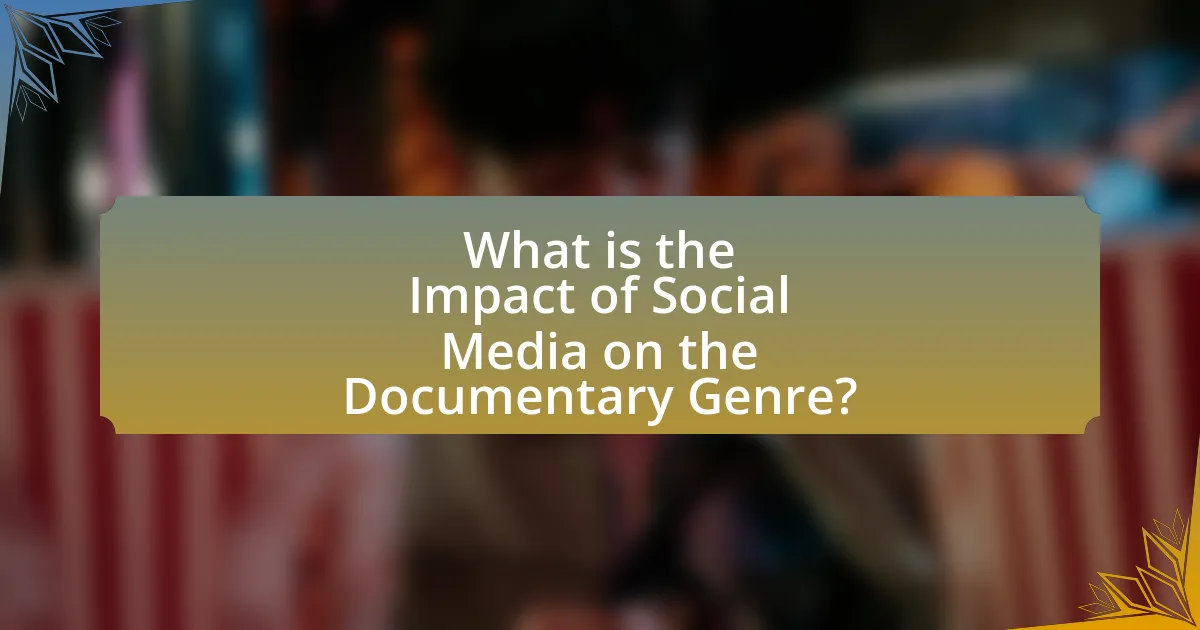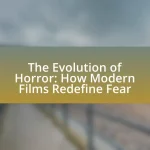The article examines the significant impact of social media on the documentary genre, highlighting how platforms like YouTube, Instagram, and Facebook enhance audience engagement and distribution. It discusses the transformation of documentary production, the emergence of new tools for filmmakers, and the influence of social media trends on documentary topics and narratives. Additionally, the article addresses the role of social media in documentary distribution, audience perception, and the challenges filmmakers face, including issues of misinformation and ethical considerations. Strategies for effectively leveraging social media to maximize impact and engage audiences are also outlined, providing a comprehensive overview of the evolving landscape of documentary filmmaking in the digital age.

What is the Impact of Social Media on the Documentary Genre?
Social media significantly impacts the documentary genre by enhancing audience engagement and distribution. Platforms like YouTube, Instagram, and Facebook allow filmmakers to reach wider audiences, facilitating immediate feedback and interaction. For instance, the documentary “13th” by Ava DuVernay gained substantial traction through social media promotion, leading to increased viewership and discussions around systemic racism. Additionally, social media enables the sharing of user-generated content, which can complement traditional documentaries and provide diverse perspectives, as seen in the rise of participatory documentaries that incorporate audience contributions. This shift not only democratizes the documentary-making process but also influences the themes and narratives explored, as filmmakers adapt to the interests and concerns expressed by their online audiences.
How has social media changed the way documentaries are produced?
Social media has transformed documentary production by enabling filmmakers to engage directly with audiences and gather real-time feedback. This shift allows creators to tailor content based on viewer interests and trends, increasing relevance and impact. For instance, platforms like Twitter and Instagram facilitate the sharing of ideas and stories, leading to more diverse perspectives and collaborative projects. Additionally, social media serves as a distribution channel, allowing documentaries to reach wider audiences without traditional gatekeepers, as evidenced by the success of films like “13th,” which gained traction through social media promotion.
What new tools and platforms are available for documentary filmmakers due to social media?
Documentary filmmakers now have access to various new tools and platforms due to social media, including TikTok, Instagram, and YouTube Shorts, which facilitate short-form storytelling and audience engagement. These platforms allow filmmakers to share snippets of their work, gather audience feedback, and build a community around their projects, enhancing visibility and funding opportunities. For instance, TikTok’s algorithm promotes content virality, enabling filmmakers to reach wider audiences quickly, while Instagram’s visual-centric approach allows for creative promotional strategies. Additionally, crowdfunding platforms like Patreon and Kickstarter have gained traction through social media, enabling filmmakers to secure funding directly from their audience.
How do social media trends influence documentary topics and narratives?
Social media trends significantly influence documentary topics and narratives by shaping public interest and discourse. For instance, trending hashtags and viral content often highlight pressing social issues, prompting filmmakers to explore these themes in their documentaries. A notable example is the rise of documentaries addressing climate change, which gained traction alongside social media campaigns like #FridaysForFuture, reflecting a growing public concern amplified through platforms like Twitter and Instagram. This alignment between social media trends and documentary content not only attracts viewership but also fosters community engagement, as audiences are more likely to support projects that resonate with current conversations online.
What role does social media play in the distribution of documentaries?
Social media plays a crucial role in the distribution of documentaries by providing platforms for filmmakers to reach wider audiences and engage viewers directly. Through social media channels like Facebook, Twitter, and Instagram, documentary creators can share trailers, behind-the-scenes content, and interactive posts that generate interest and discussion around their films. According to a study by the Pew Research Center, 69% of adults in the U.S. use social media, which enhances the potential for documentaries to gain visibility and traction among diverse demographics. Additionally, social media facilitates grassroots marketing and community building, allowing filmmakers to connect with audiences and encourage sharing, which can lead to viral promotion and increased viewership.
How do filmmakers utilize social media for audience engagement and outreach?
Filmmakers utilize social media to enhance audience engagement and outreach by creating interactive content, building communities, and leveraging targeted advertising. Through platforms like Instagram, Twitter, and Facebook, filmmakers share behind-the-scenes footage, trailers, and live Q&A sessions, fostering a sense of connection with their audience. For instance, a study by the Pew Research Center found that 69% of adults in the U.S. use social media, making it a vital tool for filmmakers to reach diverse demographics. Additionally, filmmakers can use analytics from social media platforms to tailor their marketing strategies, ensuring that their outreach efforts resonate with specific audience segments. This strategic use of social media not only increases visibility but also encourages audience participation, leading to a more engaged viewer base.
What are the advantages and disadvantages of social media distribution for documentaries?
Social media distribution for documentaries offers significant advantages and disadvantages. The primary advantage is the ability to reach a vast audience quickly; platforms like Facebook and YouTube can facilitate millions of views, enhancing visibility and engagement. For instance, a study by the Pew Research Center found that 73% of adults in the U.S. use social media, providing a broad potential audience for documentary filmmakers.
Conversely, a notable disadvantage is the risk of oversaturation and reduced content quality. With countless documentaries available online, it becomes challenging for individual projects to stand out, potentially leading to viewer fatigue. Additionally, social media algorithms can limit organic reach, meaning that even high-quality documentaries may struggle to gain traction without paid promotion. This duality highlights the complex landscape of social media as a distribution channel for documentaries.
How does social media affect audience perception of documentaries?
Social media significantly influences audience perception of documentaries by shaping their accessibility, engagement, and credibility. Platforms like Facebook, Twitter, and Instagram allow users to share opinions, reviews, and discussions about documentaries, which can enhance visibility and create a community around the content. Research indicates that 64% of viewers are more likely to watch a documentary if they see it discussed positively on social media, highlighting the role of peer influence in shaping perceptions. Additionally, social media can amplify the reach of documentaries, allowing filmmakers to connect directly with audiences, which can lead to increased trust and interest in the subject matter.
What impact does social media commentary have on documentary reception?
Social media commentary significantly influences documentary reception by shaping audience perceptions and engagement. When viewers share their thoughts and reactions on platforms like Twitter or Facebook, they create a dialogue that can enhance or diminish the documentary’s impact. For instance, a study published in the Journal of Communication found that documentaries receiving positive social media buzz tend to attract larger audiences and generate more discussions, leading to increased visibility and relevance. Conversely, negative commentary can deter potential viewers and affect the documentary’s overall reputation. This dynamic illustrates how social media serves as a powerful tool in determining the success and reception of documentary films.
How do social media platforms shape the conversation around documentary subjects?
Social media platforms shape the conversation around documentary subjects by facilitating widespread engagement and discourse among diverse audiences. These platforms enable filmmakers and viewers to share insights, critiques, and personal experiences related to documentary content, thereby amplifying voices that may not be represented in traditional media. For instance, documentaries like “13th” by Ava DuVernay gained significant traction on platforms like Twitter and Instagram, where discussions about systemic racism and criminal justice reform were catalyzed, leading to increased awareness and activism. Additionally, social media algorithms prioritize trending topics, which can elevate certain documentaries and their themes, influencing public perception and dialogue. This dynamic interaction between social media and documentary subjects illustrates how digital platforms can transform passive viewing into active participation, shaping narratives and fostering community engagement.
What challenges do filmmakers face with social media in the documentary genre?
Filmmakers in the documentary genre face significant challenges with social media, primarily related to audience engagement and content authenticity. Social media platforms often prioritize sensationalism and brevity, which can undermine the nuanced storytelling essential to documentaries. This pressure to create shareable content can lead filmmakers to compromise their artistic vision or dilute complex narratives to fit the fast-paced nature of social media. Additionally, the overwhelming volume of content on these platforms makes it difficult for documentary filmmakers to stand out and reach their target audience effectively. According to a 2021 study by the Pew Research Center, 64% of Americans believe that social media has a significant impact on how news is consumed, indicating that filmmakers must navigate a landscape where misinformation can easily spread, further complicating their efforts to convey factual narratives.
How do issues of misinformation and credibility arise in social media-driven documentaries?
Issues of misinformation and credibility in social media-driven documentaries arise primarily from the lack of rigorous fact-checking and the rapid dissemination of content. Social media platforms enable creators to share documentaries without traditional editorial oversight, leading to the potential spread of unverified information. For instance, a study by the Pew Research Center found that 64% of Americans believe that misinformation is a major problem in the media, highlighting the public’s concern regarding the reliability of information presented in such formats. Additionally, algorithms that prioritize engagement over accuracy can amplify sensationalized or misleading content, further complicating the credibility of documentaries shared on these platforms.
What are the ethical considerations for filmmakers using social media as a tool?
Filmmakers using social media as a tool must consider issues of privacy, consent, and authenticity. Privacy concerns arise when filmmakers share personal stories or sensitive information about individuals without their explicit permission, potentially violating ethical standards. Consent is crucial, as filmmakers should obtain informed consent from participants before featuring them in social media content, ensuring that individuals understand how their images and stories will be used. Authenticity is also a key consideration; filmmakers must strive to present truthful representations of their subjects and avoid misleading edits or manipulations that could distort reality. These ethical considerations are supported by guidelines from organizations like the International Documentary Association, which emphasizes the importance of ethical storytelling in documentary filmmaking.
How can filmmakers effectively leverage social media for their documentaries?
Filmmakers can effectively leverage social media for their documentaries by utilizing targeted marketing strategies, engaging with audiences, and creating shareable content. Targeted marketing strategies allow filmmakers to reach specific demographics through platforms like Facebook and Instagram, where they can promote trailers, behind-the-scenes footage, and interactive posts that resonate with potential viewers. Engaging with audiences through live Q&A sessions, polls, and discussions fosters a community around the documentary, increasing viewer investment and anticipation. Additionally, creating shareable content, such as short clips or infographics that highlight key themes or messages, encourages viewers to disseminate the documentary’s message across their networks, amplifying reach. According to a study by the Pew Research Center, 69% of adults in the U.S. use social media, making it a vital tool for filmmakers to connect with a broad audience and enhance visibility for their projects.
What strategies can be employed to maximize social media impact on documentary projects?
To maximize social media impact on documentary projects, creators should employ targeted audience engagement strategies. Engaging with specific demographics through tailored content increases visibility and fosters community interaction, which is crucial for documentaries aiming to raise awareness or provoke discussion. For instance, using analytics tools to identify audience preferences allows creators to craft posts that resonate, leading to higher shares and comments. Additionally, leveraging platforms like Instagram and TikTok, which prioritize visual storytelling, can enhance reach; studies show that video content is 1200% more likely to be shared than text and images combined. Collaborating with influencers who align with the documentary’s themes can also amplify reach, as their established audiences provide immediate access to potential viewers.
What best practices should filmmakers follow when engaging with audiences on social media?
Filmmakers should prioritize authenticity and consistency when engaging with audiences on social media. Authenticity fosters trust and connection, as audiences are more likely to engage with genuine content that reflects the filmmaker’s true voice and vision. Consistency in posting schedules and messaging helps maintain audience interest and builds a recognizable brand identity.
Additionally, filmmakers should actively respond to audience comments and messages to create a sense of community and encourage dialogue. Engaging with followers through polls, Q&A sessions, and behind-the-scenes content can enhance audience involvement and investment in the filmmaker’s projects.
Research indicates that 70% of consumers feel more connected to brands that engage with them on social media, highlighting the importance of interaction in building relationships. By following these best practices, filmmakers can effectively leverage social media to enhance their reach and impact within the documentary genre.


